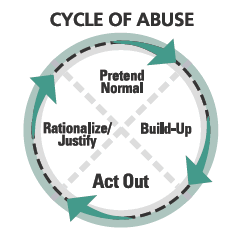
SAFETY ALERT: If you are in danger, please use a computer in a safe place, or call 911. You can leave this site quickly by clicking on Quick Escape (note: this does not clear your browser history).
Note: If you have experienced family violence and are using a computer that is shared with your abuser, use extreme caution to clear your browser history when you are finished visiting this site. If you do not know how to clear your browser, search the help available for your particular browser or use a public computer if possible.
If you are in an abusive relationship, or you know someone who may be, call 1-877-977-0007 or text 204-792-5302 or 204-805-6682.
If you are in immediate danger, call 911.
The Cycle of Abuse
On this page:
Family violence often occurs in a cycle. Understanding the cycle of violence (and the factors that influence it) is the first step towards breaking the cycle.

The cycle of abuse has four phases:
Build-up: Stress builds up in the abuse
- The cycle begins with some stress (ex: job, money or bills). The stress causes the abuser to feel powerless. The abuser chooses to act out toward a spouse or partner through name-calling, insults and accusations.
- As the tension builds, victims try to calm the abusers and try to guess ways to meet all their needs.
- The tension becomes unbearable. At this stage, victims feel like they have to be extra careful and alert around the abuser. It’s like walking on eggshells
Act Out: Tension leads to violence
- The tension that builds up in the abuser leads to severe verbal abuse, threats or a violent physical or sexual attack.
- It may happen once – but usually happens over and over.
- Abuse is always on purpose – it is never an accident. Abusers believe they need to hurt or humiliate their victims so they can feel they have the power and control in the relationship.
Rationalize/Justify: Abusers blame others, rationalize their actions
- Once they’ve committed the violent act, abusers will often blame others or use excuses to justify their actions. For example, the abuser might tell the victim: “you have been driving me crazy lately. It’s your fault this happened!” Or, he/she may make light of the violence that occurred: “I barely touched you. You’re making a big deal out of nothing!”
- These are defenses used to turn the blame away from abusers and make them feel better about themselves. Abusers then try to convince their victims that the abuser’s version of the truth is what really happened. Often, because they feel powerless to object, victims begin to doubt their own experience. They start to believe the incident really happened the way the abuser remembers it.
Pretend Normal: Acceptance of abuse
- Once the abuser has justified or rationalized his/her actions, and the victim has accepted the abuser’s version of what happened, the pretend normal stage begins. Both partners try to make the relationship continue in a normal way by pretending that everything is alright. But if the abuse is not dealt with, the cycle will continue.
- The cycle of abuse can happen over a long or short time. Often, as the cycle continues, the violence grows and the assaults become more serious.
- Victims who are caught up in the cycle of abuse often become isolated from family and friends. They may feel ashamed to see them, or may have been warned by the abuser not to talk to them. As a result, the victim becomes even more dependent on the abuser, and no one is around to help.


